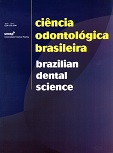Estabilidade de cor de uma resina composta indireta
DOI:
https://doi.org/10.14295/bds.2006.v9i3.238Abstract
A cor das resinas compostas indiretas é um dos mais importantes fatores no sucesso do tratamento protético. Com este material a estabilidade de cor é aspecto preponderante na longevidade deste trabalho. A proposta deste estudo foi avaliar a estabilidade de cor de resina composta indireta (Resilab Master, Wilcos – Brasil) através de um colorímetro digital. Foram confeccionados 32 corpos-de-prova (CP). Realizou-se o registro inicial da cor de cada CP, através de um colorímetro digital, que foram distribuídos em 4 grupos (n=8) e imersos em diferentes soluções. Grupo 1 (controle): água destilada/estufa; Grupo 2: água destilada/termociclagem; Grupo 3 : suco de laranja/termociclagem e Grupo 4: café/termociclagem. Após termociclagem e imersão em estufa (tempo total aproximado de 60 horas), as amostras foram enxaguadas e o registro final da cor foi obtido. Os dados foram submetidos à análise estatística (Teste de Dunnet – p<0,005). Os resultados mostraram que os valores de ΔE (diferença de cor) e desvio padrão dos grupos foram: G1: 2,35±0,84; G2: 2,97±1,21; G3: 8,33±5,87; G4: 22,38±5,33. Foi observado que os grupos 3 e 4 diferiram estatisticamente do grupo 1, exceto o grupo 2 que não foi estatisticamente significante. Baseado nos resultados, conclui-se que a termociclagem contribui para uma alteração de cor da resina composta indireta e a solução de café mancha mais do que o suco de laranja.
Downloads
Downloads
Published
How to Cite
Issue
Section
License
Brazilian Dental Science uses the Creative Commons (CC-BY 4.0) license, thus preserving the integrity of articles in an open access environment. The journal allows the author to retain publishing rights without restrictions.
=================




























